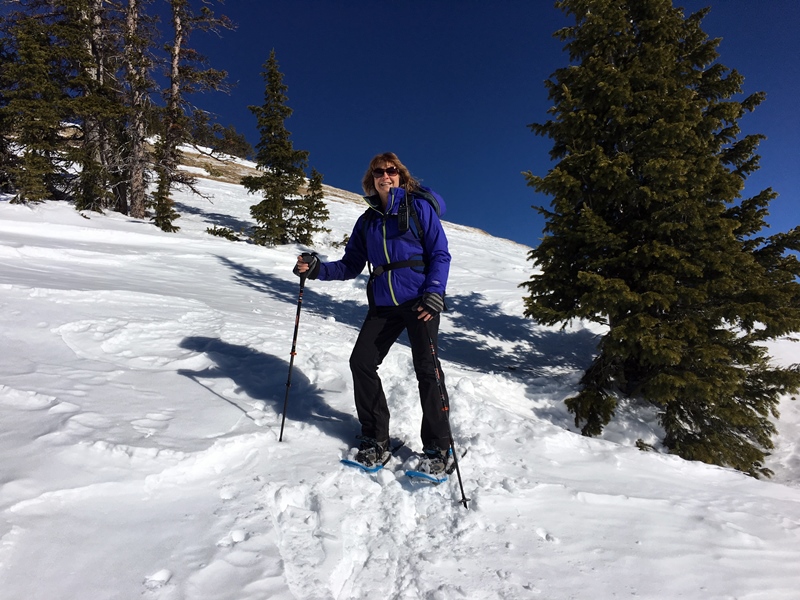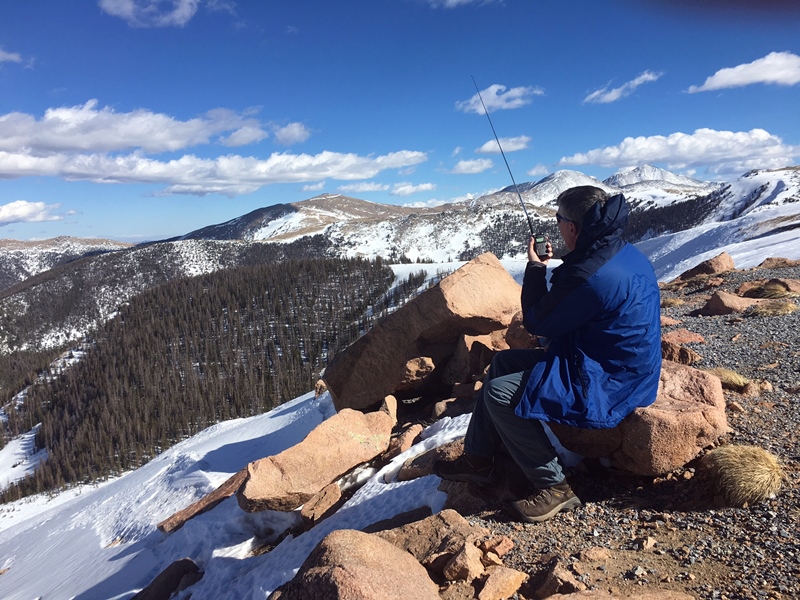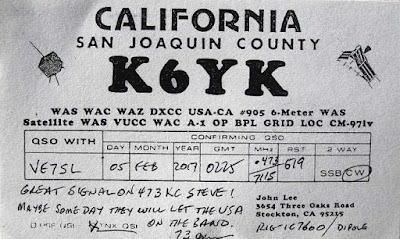 Winter SOTA on Monarch Ridge South
Winter SOTA on Monarch Ridge South
Joyce KØJJW and I were out for a little snowshoe activity near Monarch Pass in the San Isabel National Forest. Initially, we were headed to Old Monarch Pass when we noticed that the snow and weather conditions looked favorable on Monarch Ridge (also called Monarch Crest). Last winter, we tried snowshoeing Monarch Ridge twice, failing both times, once due to blizzard conditions that blew us off the summit.

Monarch Ridge South (W0C/SP-058) is the high point and a Summits On The Air (SOTA) summit, so of course it was a great idea to showshoe up there. In August of 2016, we road to the top using the tram. Take a look at that posting for more information on the summit.
For SOTA, Monarch Crest South is a versatile and very accessible peak. The slacker method is to ride the tram up during the summer months. It also can be an easy summer hike. Monarch Pass is at 11,312 feet in elevation and Monarch Crest South rises to 11,898 so the vertical gain is about 600 feet. In winter, it is a reasonable snowshoe trip. However, watch the weather carefully: you might get blown off the summit.

We started from the Monarch Pass parking lot and snowshoed straight up to the summit, roughly following the tram line. This route is simple but steep. Near the top, the ground was bare, so we removed the snowshoes and hiked on bare ground and rocks. I did not have cellphone coverage at the parking lot but I did get “one bar” about halfway up the mountain. I used this to post a SOTAwatch alert and send an email notice to hams in the area.

Just like last time, I did have some minor interference on 2m fm from the radio site at the summit, which seemed to peak up right around 146.52 MHz. Lovely. But it did not keep me from making contacts.
As you can see from the photos, it was a gorgeous day. The temperature hung around 35 degrees F with some wind at the summit, so no problem with that. Another great day in the mountains, playing with ham radio.
73, Bob K0NR
The post Winter SOTA on Monarch Ridge South appeared first on The KØNR Radio Site.
Bob Witte, KØNR, is a regular contributor to AmateurRadio.com and writes from Colorado, USA. Contact him at bob@k0nr.com.
 Amateur Radio Weekly – Issue 149
Amateur Radio Weekly – Issue 149
What drove Radio Shack into bankruptcy?
After two years of unsuccessful turnaround efforts, RadioShack filed for its second bankruptcy on Wednesday, citing poor mobile sales.
The Christian Science Monitor
Runt radials
Antennas shipping with ineffective antenna decoupling are on the rise as manufacturers daringly advocate 1/12 wave radials work.
Ham Radio . Magnum Experimentum
APRS explained in simple terms
In this episode of the Ham Radio 360 Podcast, Kenneth Finnegan (W6KWF) helps explain the APRS protocol.
Ham Radio 360
How to: Boafeng UV5R USB soundcard interface
The main idea for this project was to replace the external speaker microphone functionality with that of the USB soundcard.
High on Solder
Origin of wireless security: The Marconi radio hack of 1903
Marconi is about to demonstrate his new wireless system, which he claims can securely send messages over a long distance, without interference by tuning the signal.
Hack A Day
Breaking the cheap Ham stereotype?
Both sell high-quality, somewhat expensive products, and I was a little surprised that neither had any complaints based on the general characterization of hams as cheap.
Ham Radio Now
Review: 12 watt tri-band HT
The brand new JT-5988HP is a 12-watt, tri-band radio with a 4800mAh battery from JINGTONG, a handset and parts supplier out of China.
Prepari
A review of the Elecraft K-Pod
This was a nice addition to my K3 as for me it’s handy to have the VFO control right beside the key.
VE3WDM
Video
Yaesu FT-450D Mic Test Comparison: MD100a8x vs. Stock MH-31a
Test of transmitted audio from Yaesu FT-450D (as received on an FT-950) in DX conditions — a comparison between the MD100a8x, at various settings, vs. Stock MH-31a.
YouTube
Intro to Fldigi
Fldigi’s user interface and basic transmit & receive operations.
K4REF
Amateur Radio Weekly is curated by Cale Mooth K4HCK. Sign up free to receive ham radio's most relevant news, projects, technology and events by e-mail each week at http://www.hamweekly.com.
 HF Ham Radio Kenwood TS-50S Panel Button Repair
HF Ham Radio Kenwood TS-50S Panel Button Repair
The buttons in my Kenwood TS-50S ham radio started falling out when the foam inside started getting old. The foam was the only thing holding the buttons in so I used jewelry repair rings from Michaels Store to clamp around the base of the buttons inside the bezel face plate which then holds the buttons in nicely yet lets them have full travel and good tactical feel.
Todd Harrison, KF7NBI, is a regular contributor to AmateurRadio.com and writes from Arizona, USA.
 US exams at Wyong
US exams at Wyong
About midway through January, I heard via a Sunday morning WIA broadcast that a group of ARRL Volunteer Examiners was offering to hold exam sessions at the Wyong Field Day at the end of February.
I passed my original amateur license exam here in Australia almost 40 years ago. My AOCP (Amateur Operator’s Certificate of Proficiency) says I passed a test on 21st November 1978. (That was probably the date of my second or third attempt to pass the morse at 10 wpm test.)
For the exam, I also had to answer questions about radio regulations and to demonstrate “a knowledge of wireless telegraphy and wireless telephony and electrical principles”, I had to write a number of essays about things like neutralizing a valve (tube) power amplifier or how a superheterodyne receiver works. A lot has changed since then. New technology like software defined radio and the internet.
After I heard that local hams were conducting US license exams here, my first resolution of the year was to pass the US exams for all three levels.
I was surprised that I was able to do this. All the FCC required was an online registration of an FRN (an FCC Registration Number) using a US address which was easy enough to obtain without having to pay a monthly fee. Also for the US, there is no license fee and licenses have a term of ten years.
With just on six weeks to prepare I planned to work sequentially through the three levels, spending more time on the hardest level, Extra. With no time to spare I ordered Kindle versions of the license manuals for all three levels. I also downloaded copies of the freely available complete question pools for each level. The exams are objective tests based on random selections from every part of all of the ten main exam topics – 35 questions for Technician and General, and 50 for Extra.
 The license manuals essentially re-arrange the hundreds of disparate questions into a more or less flowing narrative about how to be a modern ham radio operator.
The license manuals essentially re-arrange the hundreds of disparate questions into a more or less flowing narrative about how to be a modern ham radio operator.
As I worked my way through the manuals I would mark up the questions and answers in my copies of the question pools and make notes if necessary to explain the answer.
The information in the manuals was very well presented and manageable and digestible. I loved the way liberal amounts of ham radio wisdom about operating practice was added to the mix. It was really like having your own personal Elmer guiding you through the intricacies of aspects of the hobby that previously were unclear or were new to me.
Best of all for me the study process demystified a lot of the mathematics of electronics and set me on a path to better understand what after all is the basis of the ‘magic’ of radio. I love the fact that the Scottish mathematician Maxwell concluded radio waves must exist, just from the maths, many years before they were actually discovered or produced by Hertz and others.
The ARRL web pages supporting the license manuals has links to a range of other resources including a page of references that pointed me to a really brilliant site which sets out to systematically (and enjoyably) explain the advanced maths to those whose school maths didn’t quite reach those dizzy heights, like me. It’s highly recommended if you want to delve deeper.
I’m happy to say I passed all three exams. I received an email from the FC about two weeks after the tests. There was no real need to do it, but it was a personal challenge – a little like voluntarily doing a driving test again, times three. It also turned out to be a convenient way to calibrate and update my ham radio knowledge.
The session was well organised and afterward, one of the VEs demonstrated how he uses his US call by connecting via remoteham.com on his iPad to a contest-grade station high in the hills in New York state. Amazing and fast! At rates around a US$ a minute, this must be a good way to turn a remote location into a source of revenue to be earned from the hordes of hams living in cities with a high level of local electrical noise.
 CQ Crossband and … 3 Down, 97 To Go!
CQ Crossband and … 3 Down, 97 To Go!
Several QSL cards have arrived after the last 630m 'crossband' event ... including one from ZF1EJ in the Cayman Islands confirming our 630m QSO in January.
The contact was made on JT-9, the 'WSPR QSO' mode, and represents DXCC country #3 for me on 630m ... only 97 more to go! ZF1EJ was running just 32 watts output when we had our 630m JT-9 contact but has since cranked his output to around 60 watts. Eden is beaconing most nights on WSPR and puts out a well-heard signal. He is very interested in two-way JT-9 work with other VE stations as well as any Europeans and down-under stations.
From what I can tell, it looks like JT-9 (similar to JT-65 but a much narrower bandwidth of 15.6Hz) is establishing itself as the go-to mode for weak signal two-way work on 630m. It has a couple of things going for it that makes it very attractive for this band ... it can dig way down into the noise (-25 db approximately) and communicate with very weak signals and, it does not require amateurs to know CW, a growing trend with newer operators and a real hindrance to two-way CW work. I suspect, and hope, that there will be much more CW activity on 630m once amateurs in the U.S.A. get the band as the amount of information that can be exchanged per transmission on JT-9 is limited ... time will tell.
In the meantime, here is a request for more two-way 'crossband' CW activity with amateurs in all parts of North America. I have recently totally revised the 'CQ Crossband' page on my website, 'The VE7SL Radio Notebook'. Please note that my web address for well over a decade, is no longer valid and everything has been moved to this new location. If you have the old one bookmarked or are linking to it from your own site, please be aware that previous links will now be dead.
The crossband concept allows amateurs not yet on 630m to still participate in this exciting part of the spectrum ... and to check out their ability to hear anything on MF. If we were to make a schedule for a crossband contact, I would be transmitting on 630m at full ERP while you would be answering on one of the HF bands ... usually 160, 80 or 40m.
I am very much interested in setting up crossband schedules for 630m at any time and can very likely enlist several other VE7s to be there as well so that you can work more than one station. I have full details on my updated 'CQ Crossband' web page but please do not hesitate to give crossband a try!
Roger, VE7VV in Victoria, B.C., recently became the 8th VE7 to muster RF on 630m, with power limited to 1 watt at present. Our contact was on CW while he worked stations in Vancouver on JT-9. Hopefully he will continue to build his station and become more active on the band.
Crossband continues to be a subject of much interest both here and with many U.S. stations that are waiting for the band. Recent cards from Colorado and California, shown below, are the latest to arrive.
K6YK gave me an RST of '519' but explained the reason for this was because he was receiving on his 3 el HF tri-bander which provided the best signal-to-noise value! This is often the case on 630m so try what you have. Many times a 'non-resonant' antenna will pick up less noise and yield the best signal readability.
If you would like to try a crossband QSO, please contact me at VE7SL (at) shaw.ca ... I'll keep the rig warmed up!
Steve McDonald, VE7SL, is a regular contributor to AmateurRadio.com and writes from British Columbia, Canada. Contact him at ve7sl@shaw.ca.
 CQ Crossband and … 3 Down, 97 To Go!
CQ Crossband and … 3 Down, 97 To Go!
Several QSL cards have arrived after the last 630m 'crossband' event ... including one from ZF1EJ in the Cayman Islands confirming our 630m QSO in January.
The contact was made on JT-9, the 'WSPR QSO' mode, and represents DXCC country #3 for me on 630m ... only 97 more to go! ZF1EJ was running just 32 watts output when we had our 630m JT-9 contact but has since cranked his output to around 60 watts. Eden is beaconing most nights on WSPR and puts out a well-heard signal. He is very interested in two-way JT-9 work with other VE stations as well as any Europeans and down-under stations.
From what I can tell, it looks like JT-9 (similar to JT-65 but a much narrower bandwidth of 15.6Hz) is establishing itself as the go-to mode for weak signal two-way work on 630m. It has a couple of things going for it that makes it very attractive for this band ... it can dig way down into the noise (-25 db approximately) and communicate with very weak signals and, it does not require amateurs to know CW, a growing trend with newer operators and a real hindrance to two-way CW work. I suspect, and hope, that there will be much more CW activity on 630m once amateurs in the U.S.A. get the band as the amount of information that can be exchanged per transmission on JT-9 is limited ... time will tell.
In the meantime, here is a request for more two-way 'crossband' CW activity with amateurs in all parts of North America. I have recently totally revised the 'CQ Crossband' page on my website, 'The VE7SL Radio Notebook'. Please note that my web address for well over a decade, is no longer valid and everything has been moved to this new location. If you have the old one bookmarked or are linking to it from your own site, please be aware that previous links will now be dead.
The crossband concept allows amateurs not yet on 630m to still participate in this exciting part of the spectrum ... and to check out their ability to hear anything on MF. If we were to make a schedule for a crossband contact, I would be transmitting on 630m at full ERP while you would be answering on one of the HF bands ... usually 160, 80 or 40m.
I am very much interested in setting up crossband schedules for 630m at any time and can very likely enlist several other VE7s to be there as well so that you can work more than one station. I have full details on my updated 'CQ Crossband' web page but please do not hesitate to give crossband a try!
Roger, VE7VV in Victoria, B.C., recently became the 8th VE7 to muster RF on 630m, with power limited to 1 watt at present. Our contact was on CW while he worked stations in Vancouver on JT-9. Hopefully he will continue to build his station and become more active on the band.
Crossband continues to be a subject of much interest both here and with many U.S. stations that are waiting for the band. Recent cards from Colorado and California, shown below, are the latest to arrive.
K6YK gave me an RST of '519' but explained the reason for this was because he was receiving on his 3 el HF tri-bander which provided the best signal-to-noise value! This is often the case on 630m so try what you have. Many times a 'non-resonant' antenna will pick up less noise and yield the best signal readability.
If you would like to try a crossband QSO, please contact me at VE7SL (at) shaw.ca ... I'll keep the rig warmed up!
Steve McDonald, VE7SL, is a regular contributor to AmateurRadio.com and writes from British Columbia, Canada. Contact him at ve7sl@shaw.ca.
 ICQ Podcast Episode 232 – Bitx 40 Part One
ICQ Podcast Episode 232 – Bitx 40 Part One
In this episode, Martin M1MRB / W9ICQ is joined by Leslie Butterfield G0CIB, Edmund Spicer M0MNG and Chris Howard M0TCH to discuss the latest Amateur / Ham Radio news. Colin M6BOY rounds up the news in brief, and this episode’s features is Bitx 40 Part One.
We would like to thank Richard Langmead, 5B4AJG and our monthly and annual donors for keeping the podcast advert free. To donate, please visit - http://www.icqpodcast.com/donate
- Ham Radio Dummies Books for Schools and Libraries
- Ham Radio Clubs Encouraged to Innovate
- Cadet Radio Exercise BLUE HAM 2
- Comments on ARRL Petition to Allocate New 5 MHz Band
- Disney Research Demonstrates Open-Air Wireless Charging
- Hamvention Field Trip
- NASA Launches Two CubeSats with Transponders
- St Patrick's Day 2017 Award
- Radio Hams Celebrate 2MT
Colin Butler, M6BOY, is the host of the ICQ Podcast, a weekly radio show about Amateur Radio. Contact him at info@icqpodcast.com.




















